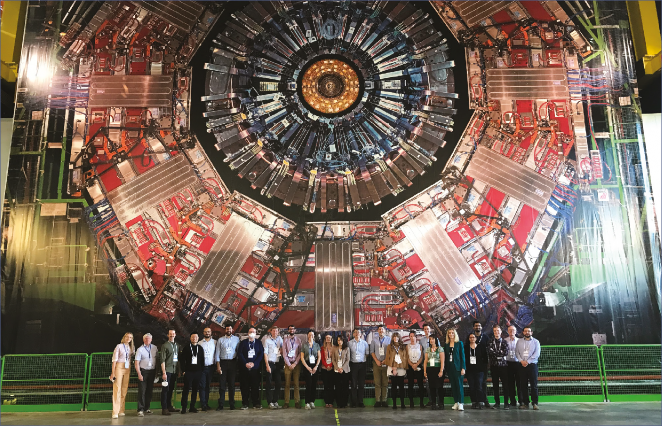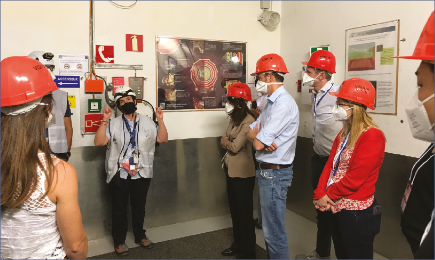FST JOURNAL
Future Leaders
The Foundation Future Leaders programme aims to acquaint early- to mid-career professionals in Government, research and industry with different examples of science and innovation in action. This September, members of the programme had the opportunity to travel to the Centre for European Nuclear Research (CERN) in Geneva, Switzerland. Daniel Garbutt gives his assessment.
DOI: https://www.doi.org/10.53289/IEMZ1229
An international focus for fundamental research
Daniel Garbutt
Daniel Garbutt BSc(Hons) MSc CEng MICE FGS is Critical Enablers Strategy Technical Lead at Magnox Ltd, part of the Nuclear Decommissioning Authority. He is a member of the Foundation Future Leaders Programme 2022.
The day of the visit began with a visit the microcosm exhibition, housed inside a large model – several stories in height – of an elementary particle. This exhibition gave an immersive introduction to the mission of CERN and some of the key developments in its history to date, providing a fitting primer to begin the rest of the day.
The official visit began in IdeaSquare, the innovation space for CERN. This space was quirky but functional, housing a double-decker London bus as well as various modules where ideas could be prototyped and explored.
The idea behind IdeaSquare is admirable and well-suited to unlocking the creativity around innovation, with the tagline of it being ‘a place to dream’. The vision is not just to go beyond the currently impossible but to encourage the realisation of the unthinkable through innovation.
After enjoying an initial tour of the facility, the first of a series of presentations began with a description of the scientific challenges and future programmes at CERN provided by Pippa Wells, Deputy Director for Research and Computing. Pippa introduced the cohort to the four pillars that underpin CERN’s mission:
- Research
- Education and training
- Collaboration
- Technology and innovation.
There are three key areas in which CERN develops technologies; these are accelerators, detectors and computing. The group was introduced to the Large Hadron Collider (LHC), its configuration and the various experiments at each of the detectors.
The largest of the detectors on the LHC is ATLAS at 44 metres long and 25 metres in diameter. It is designed to record the high-energy particle collisions of the LHC that take place at a rate of over a billion interactions per second, helping us understand the fundamental building blocks of matter, the fundamental forces of nature, and the nature of dark matter.
The Compact Muon Solenoid (CMS) is the other large general-purpose detector and is built around a large solenoid magnet. Identifying muons is one of the key tasks for this detector as they are one of the most important signatures of the Higgs-Boson. A visit to this facility was included on the day’s programme, with delegates able to descend 90 metres below ground to see the data centre which has the task of collating and sorting the vast amounts of information collected during experiments.
The scientific priorities for the future for CERN have been drawn from the 2020 Update of the European Strategy for Particle Physics:
- Fully exploit the High Luminosity LHC
- Build a Higgs factory to further understand this unique particle
- Investigate the technical and financial feasibility of a future energy-frontier 100 km collider at CERN
- Ramp up relevant R&D
- Continue supporting other projects around the world.
Following Pippa, Brennan Goddard gave a presentation on the development of accelerator technologies for the future – highlighting the role of technology at CERN. In radio frequency accelerators, the particle gains a small amount of energy each time it passes the accelerating structure with the magnets used to steer the particle beam round the ring back to the acceleration point. The higher the energy the stronger the magnets need to be.
CERN has identified several superconducting radio frequency research and development areas, such as cavity studies, cryomodule development and power sources for radio frequency.
CERN is also developing some enabling technologies such as high-accuracy, synchronised timing solutions, radiation-tolerant electronics and various robotic technologies as well as machine learning for accelerator operation and geodetic metrology.
One of the future programmes at CERN is the high luminosity hadron collider, a one billion Swiss franc upgrade to LHC, designed to achieve a fivefold increase in the number of instantaneous collisions, enabling the experiments to enlarge their data sample by an order of magnitude compared with the LHC baseline programme.
A larger circular collider is currently at feasibility study stage. This proposed collider would provide much higher energy collisions, achieved through a larger diameter of ca 90km.
 The Future Leaders group in front of a life-size image of the CMS detector at CERN
The Future Leaders group in front of a life-size image of the CMS detector at CERN As part of the presentations at IdeaSquare the future leaders were given an understanding of the governance that enables CERN as well as the current approach to procurement.
 members of the group being briefed by CERN staff before descending more than 80m to the level of the Large Hadron Collider.
members of the group being briefed by CERN staff before descending more than 80m to the level of the Large Hadron Collider. Diversity goal
CERN’s Director-General is Fabiola Gianotti, the first woman to hold this position. Some 19% of the workforce are female and it is an aim of the organisation to improve this metric over the coming years.
One of the fundamental principles that CERN has been founded upon, is its use for peaceful purposes. This is a consequence of it being founded at the end of the Second World War. Europe was dealing with the aftermath of this horrific episode in its history, and this manifested itself in various initiatives for peaceful collaboration and cooperation. CERN was then founded in 1954 as a vehicle to provide world class research in particle physics and to mitigate the brain drain from a post-war Europe.
For the 2022 funding cycle the United Kingdom provided the second largest input. This totalled 14.2% of CERN’s budget, yet the industrial returns to the UK are rated at very poor. This in effect means that UK businesses are not often successfully winning contracts across the organisation. CERN has identified that this imbalance is something it needs to address and is currently working with the Science and Technology Facilities Council (STFC) to improve outreach and support for UK tenders and winners.
The visit provided a striking insight into how such an historic and important multinational science project is governed, financed, technically-managed and delivered.
